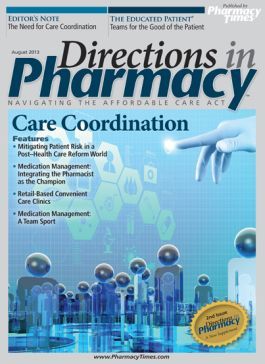Publication
Article
Pharmacy Practice in Focus: Oncology
Care Coordination: Mitigating Patient Risk in a Post-Health Care Reform World
Pharmacists have new opportunities for expanding their role in the care continuum.

Pharmacists have new opportunities for expanding their role in the care continuum.
In the first edition of the Directions in PharmacyTM series (www.pharmacytimes.com/health-care-reform), we focused on the inevitability of health care reform—regardless of the Affordable Care Act (ACA)—and the extremely rapid pace with which foundational changes are occurring in the United States health care system.
Without a doubt, the trend is to transfer financial risk to providers after many decades of success for the fee-for-service reimbursement model.
In that old world, the risk paradigm started and ended with the patient encounter. For hospitals, it was the time between admission and discharge. For the pharmacy, it started at prescription intake and ended when the prescription was closed out at the register.
Most providers have heretofore been relatively insulated from the upstream and downstream actions of patients and other providers. Provider risk was ultimately housed within the providers’ 4 walls, and these providers had a great deal of control over their own environment. But in the new paradigm—which is centered on patient outcomes and total cost of care—risk transcends the 4 walls of your practice site.
It is a scary proposition to think that your pharmacy practice may be financially or otherwise contractually responsible for the actions of other providers and, ultimately, the actions of patients themselves. Have you ever been reimbursed based on what happened to your patient after they left the hospital, pharmacy, clinic, or long-term care setting?
If you haven’t, you will. Whether directly through shared financial risk or indirectly through a performance incentive (or disincentive), you will be at risk for the performance throughout the entire care continuum.
These new payment models have driven providers to respond 1 of 2 ways: 1) purchase, affiliate, or otherwise consolidate multiple provider types across multiple settings of care, or 2) establish working collaborations across those providers and settings of care, either through explicit contracting or through informal agreement, to aid in mitigating the risk held by the provider who is at risk. Whether penalties for high rates of 30-day readmissions, or incentives for increased patient medication adherence (Medicare Star Ratings), reducing the total cost of care by improving the health trajectory of a patient requires an effective care delivery ecosystem.
In this new edition of the Directions in PharmacyTM supplement series, we focus on “Care Coordination: Who, What, When, Where, and How?”—and we explore the relationship between pharmacists in their respective settings of care with caregivers and care providers who operate other settings of care. We sought authors who would challenge the traditional norms of pharmacy practice, particularly the notion that “medication management” is under the exclusive purview of the pharmacist, physician, nurse, or other health care provider.
Ask yourself the following questions:
- “Five years from now—how will I interact with other care team members in other settings for the patients I serve?”
- “What tasks should I be performing instead of other care team members?”
- “What tasks should other care team members be performing that aren’t an effective use of my time?”
- “What non-traditional roles will emerge and what will be the role of laypeople, family members, or acquaintances on the care team?”
- And perhaps most importantly, “How do I effectively work with all of these different provider types in all of these different settings efficiently and in a financially justifiable manner, so that the return exceeds the investment of my time or my staff’s time?”
Troy Trygstad, PharmD, PhD, MBA, is the director of the Network Pharmacist Program and Pharmacy Projects for Community Care of North Carolina (CCNC), a parent organization of 14 regional care management networks. These networks bring together medical practices, county health departments, hospital systems, and mental health providers to integrate care delivery for Medicaid, Medicare, private plans, employers, and the uninsured. CCNC and its networks are responsible for developing and evaluating accountable care systems in North Carolina. Under his direction at CCNC, the Network Pharmacist Program has grown to include pharmacists who are involved in a number of diverse activities ranging from patient-level medication reconciliation to practice level e-prescribing facilitation to network-level management of pharmacy benefits. Dr. Trygstad also plays an integral role in health information technology adoption and proliferation with CCNC practices and across the state, leading electronic prescribing adoption efforts as well as the development and deployment of a statewide medication management platform. He has been involved in novel adherence implementations as well as the development of adherence technologies that use administrative claims data to predict, intervene, and triage adherence interventions and coaching opportunities. Dr. Trygstad received his PharmD and MBA degrees from Drake University and a PhD in pharmaceutical outcomes and policy from the University of North Carolina. He is co-editor of the Pharmacy Times series on Directions in PharmacyTM.







